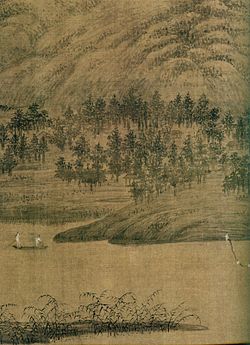- Dong Yuan
-
Dong Yuan 
Detail from Xiao and Xiang Rivers, permanent collection at the Palace Museum. This is often considered to be one of Dong Yuan's greatest masterpieces, and it "illustrates the revolutionary impressionism" he had achieved by "means of broken ink washes and the elimination of the outline."[1]Born c. 932
NanjingDied c. 962 Nationality Chinese Field Painting Movement Southern Tang, Jiangnan style Influenced Juran Dong Yuan (Chinese: 董源; pinyin: Dŏng Yuán; Wade–Giles: Tung Yüan, Gan: dung3 ngion4) (c. 934 – c. 962) was a Chinese painter.
He was born in Zhongling (钟陵) (present day Jinxian (进贤) of Jiangxi Province).[2] Dong Yuan was active in the Southern Tang Kingdom of the Five Dynasties and Ten Kingdoms Period. He was from Nanjing in the Jiangsu province, which was a center for culture and the arts.
He was known for both figure and landscape paintings, and exemplified the elegant style which would become the standard for brush painting in China for the next nine centuries. He and his pupil Juran (巨然) were the founders of the Southern style of landscape painting, known as the Jiangnan Landscpe style. Together with Jing Hao and Guan Tong of the Northern style they constituted the four seminal painters of that time.
As with many artists in China, his profession was as an official, here he studied the existing styles of Li Sixun and Wang Wei. However, he added to the to these masters' techniques; he included more sophisticated perspective, the use of pointillism and the use of crosshatching to build up a vivid effect.
Contents
Works
The Xiao and Xiang Rivers or Scenes along the Xiao and Xiang Rivers, a painting on silk (49.80 cm by 141.30 cm),[3] is one of his best-known masterpieces. It demonstrates his exquisite techniques, and his sense of composition. The clouds break the background mountains into a central pyramid composition and a secondary pyramid, by softening the mountain line, he makes the immobile effect more pronounced.
The inlet by breaking the landscape into groups makes the serenity of the foreground more pronounced, instead of simply being a border to the composition, it is a space of its own, into which the boat on the far right intrudes, even though it is tiny compared to the mountains. Left of center, he uses his unusual brush stroke techniques, later copied in countless paintings, to give a strong sense of foliage to the trees, which contrasts with the rounded waves of stone that make up the mountains themselves. This gives the painting a more distinct middle ground, and makes the mountains have an aura and distance which gives them greater grandeur and personality. He also used "face like" patterns in the mountain on the right. Another of Dong Yuan's painting The Riverbank is housed in the Metropolitan Museum of Art, and was a gift from New York financier Oscar Tang.[4]
Gallery
Xiao and Xiang Rivers (潇湘图). Part of a handscroll, ink and color on silk, Palace Museum, Beijing.Wintry Groves and Layered Banks, ca. 950. Hanging Scroll, ink and color on silk, Kurokawa Institute, Japan.See also
- Culture of the Song Dynasty
- Chinese painting
- Chinese art
- Eight Views of Xiaoxiang
- History of Chinese art
- Xiaoxiang
Notes
- ^ Sullivan, Michael (1999). The Arts of China. University of California Press. p. 173. ISBN 0520218779.
- ^ Cihai: Page 599.
- ^ "The Huntington Archive". Ohio State University. http://huntington.wmc.ohio-state.edu/public/index.cfm?fuseaction=showThisDetail&ObjectID=30019158.
- ^ JUDITH H. DOBRZYNSKI (May 25, 1997). "Landscapes Were Never The Same". The New York Times. http://www.nytimes.com/1997/05/25/weekinreview/landscapes-were-never-the-same.html. Retrieved 2010-01-10. "Southern Tang Dynasty scholar Dong Yuan created the illusion of depth and distance ... the Metropolitan Museum of Art ... The Riverbank, ...it had been bought for the Met by the financier Oscar L. Tang."
References
- Ci hai bian ji wei yuan hui (辞海编辑委员会). Ci hai (辞海). Shanghai: Shanghai ci shu chu ban she (上海辞书出版社), 1979.
External links
- Dong Yuan and his Painting Gallery at China Online Museum
Categories:- 934 births
- 962 deaths
- Chinese painters
- Southern Tang painters
- Landscape artists
Wikimedia Foundation. 2010.




